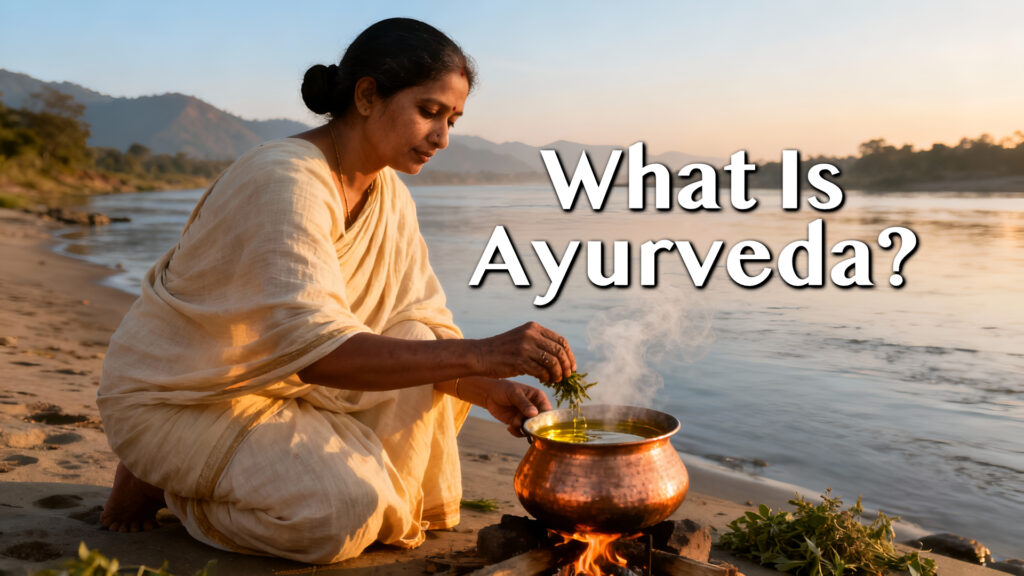Welcome to the world of ancient healing. This old practice started in India over 5,000 years ago. It teaches how to live a balanced and healthy life.
This system sees health as a balance. It links the body, mind, and spirit in a special way. It aims to heal and keep you well for good.
People all over the world follow these natural health ideas. They find it useful for today’s life. It teaches that being well means being in harmony with ourselves and the world.
This way of life gives us a strong guide for every day. It suggests natural fixes and care before problems start. Trying this path can make life more vibrant and balanced.

What Is Ayurveda? — A Comprehensive Overview
This ancient wellness system offers a deep way to see our gbosky connection. It looks at the cause of problems, not just the symptoms.
Defining Ayurveda and Its Philosophy
The name comes from Sanskrit, meaning “science of life.” It’s one of the oldest medicine forms. It believes everything in the world is connected.
Being healthy means your body, mind, and spirit are in sync. When they’re not, due to stress or bad habits, sickness can happen. Ayurveda sees balance as key for a lively life.
The “Science of Life” Explained
At its heart is the idea of prana, or life energy. This energy must flow well in the body and mind for health. It’s like blood flow for our health.
Ayurvedic medicine uses natural treatments and lifestyle changes to fix this flow. It knows each person is different, with a unique prakriti. So, treatments are made just for you.
The goal is to find lasting balance. This leads to a happy and fulfilling life.
Historical Roots and Evolution of Ayurveda
This healing science started in India’s Vedic period thousands of years ago. It grew in a culture that valued natural balance.
Ancient Origins and Vedic Traditions
Over 5,000 years ago, this wisdom began. It came from the Vedic civilization’s deep understanding of nature.
The knowledge was passed down orally for many generations. Masters taught disciples directly. This kept the teachings pure.
The Journey from Oral Tradition to Modern Practice
Later, some texts were written down. Much wisdom is still lost today. What we have now is from these texts.
This system has influenced many healing practices worldwide. Homeopathy and polarity therapy come from it. Ayurveda is called the “Mother of All Healing” for this reason.
In modern India, it’s a formal medical system. Schools and hospitals follow this ancient wisdom. About 80% of India’s people use this traditional medicine today.
Core Principles and Doshas in Ayurveda
At the heart of this ancient wellness system lies a key idea. It explains why we’re all different in health and personality. The three doshas—vata, pitta, and kapha—are the core of this traditional medicine.
Understanding Vata, Pitta, and Kapha
These energy types come from five elements. Vata is made of space and air. It controls movement, flexibility, and breathing.
Pitta comes from fire and water. It handles digestion, metabolism, and body heat. It turns food into energy.
Kapha is made of water and earth. It gives structure and stability. It also keeps joints moving and fights off sickness.
The Role of Individual Constitution (Prakriti)
Everyone has a mix of these doshas. This mix is called prakriti. While all three are in everyone, one or two are usually more.
Finding the right mix of vata, pitta, and kapha is key for health. If they’re not balanced, it can cause problems. But when they are, it leads to wellness.
Knowing your constitution helps you make better choices. It helps keep you healthy and prevents sickness.
Ayurvedic Practices for Holistic Health
Daily routines and special treatments gbo303 bring Ayurveda to life. They work together to keep you healthy and prevent sickness.
Herbal Remedies and Natural Treatments
Herbal medicine is a big part of this. Doctors pick herbs like turmeric and ginger based on what you need.
These natural products help get your body back in balance. The right mix depends on your constitution.
Detoxification through Panchakarma
Panchakarma is a deep cleaning program. It removes toxins from your body.
It includes massages and herbal treatments. These help clean deep inside.
This makes your body stronger. It helps you stay balanced and healthy.
Diet and Lifestyle Modifications in Ayurveda
Adjusting your diet and daily life to your constitution is important. This view sees food as medicine. The right diet and lifestyle choices help you find balance.
Tailoring Foods and Routines to Your Dosha
Vata types need a grounding diet. Warm, cooked foods like soups and stews are comforting. Eating small meals often helps digestion and energy.
Sweet fruits and healthy oils help with vata‘s dryness. This brings calm and stability.
Pitta types do well with cool foods. Salads, raw vegetables, and sweet fruits are good. A vegetarian diet is best for cooling pitta.
Kapha types need light, stimulating foods. Bitter leafy greens and above-ground vegetables are great. Eating small portions and using pungent spices helps digestion for kapha.
Timing Your Meals for Better Digestion
Eat your biggest meal at midday. This matches your body’s strongest digestion time. This simple change can significantly improve how you process nutrients.
Integrating Ayurveda with Western Medicine
Mixing old and new medicine ways can help health a lot. It lets people use the best of both worlds.
Complementary Approaches for Modern Health
Western medicine is great for quick fixes and emergencies. It uses medicines and surgery to fix problems fast.
Ayurveda works on keeping energy balanced. It helps the body fight off sickness better. Together, they make a strong health plan.
Safety Considerations and Certification Insights
It’s important to be safe when mixing medicines. The FDA says about 20% of ayurvedic products have harmful metals like lead and mercury.
Always talk to your doctor before trying new supplements. Work with a trained expert who checks products safely.
The U.S. doesn’t have a national license for this practice. But groups like the National Ayurvedic Medical Association set standards. Choosing certified experts makes it safer.
Ayurvedic Insights on Mental and Emotional Wellbeing
This old system says true health is about both mind and body. It sees mental health as part of overall health, offering a full plan for feeling balanced.
Mindfulness, Meditation, and Stress Management
Meditation is very good for your mind. It can lower anxiety and help deal with stress. Many people sleep better too.
People with different types need different ways to meditate. Vata types like walking meditation because sitting is hard. It fits their active minds.
Pitta types might get angry or make quick decisions. Doing calm things like moon gazing or swimming helps. These calm the hot feelings in their minds.
Kapha types might feel tired or resist change. Doing fun, active things wakes them up. Moving every day keeps their minds sharp.
Simple tricks like box breathing can help with stress. Having a quiet place to sleep helps health too. Even a little meditation each day can make people happier.
Ayurvedic Treatments and Solutions for Common Conditions
Ayurveda offers natural ways to solve health problems. It finds the real cause, not just the symptoms.
Managing Stress, Anxiety, and Digestion Naturally
Each person’s health issue is different. Vata types might feel anxious and have stomach problems. Pitta types might have skin issues and inflammation. Kapha types might gain weight and feel slow.
Research shows certain herbs can help. Ashwagandha lowers stress. Turmeric fights inflammation. Ginger helps digestion. These natural ways help the body heal itself.
Personalized Treatment Plans for Lasting Balance
Good treatment fits each person’s special needs. There’s no one solution for everyone. A skilled practitioner looks at your dosha and health to make a plan.
They mix diet, lifestyle, and herbs to help you. This custom plan meets your needs. Consistent effort leads to lasting results.
Herbal and Lifestyle Interventions Reviewed
Small changes can make a big difference. Eating big meals at midday helps digestion. Exercise that fits your energy keeps you lively.
Good sleep and stress control improve health. These steps together help restore balance. Many see improvements in just weeks of following their plan.
Conclusion
This journey to wellness is about making choices every day. These choices help you feel your best. Balance comes from simple, daily habits.
Getting enough sleep and moving your body is key. Eating fresh food like fruits and vegetables is also important. Try adding herbs like turmeric or ginger to your meals.
Knowing your constitution helps you pick the right foods and activities. This keeps your energy up. For the best treatment, talk to a practitioner.
This old medicine still helps us today. Small, daily actions can make you strong and healthy. They help prevent disease.
 Ramon Mascarenas is the owner of PalmLeaf Massage & Wellness. Jen Mascarenas is his wife and a vegan who believes in a whole-food, plant-based diet to promote vitality. She shares vegan recipes and writes abstract research articles for PalmLeaf Massage & Wellness. Ramon Mascarenas and his associates have licensed massage therapists who practice Myofascial Trigger Point Therapy and other medical massage modalities. Their services expanded along with Acupuncture and Chiropractic care to promote wellness and help clients with pain management through self-care exercises.
Ramon Mascarenas is the owner of PalmLeaf Massage & Wellness. Jen Mascarenas is his wife and a vegan who believes in a whole-food, plant-based diet to promote vitality. She shares vegan recipes and writes abstract research articles for PalmLeaf Massage & Wellness. Ramon Mascarenas and his associates have licensed massage therapists who practice Myofascial Trigger Point Therapy and other medical massage modalities. Their services expanded along with Acupuncture and Chiropractic care to promote wellness and help clients with pain management through self-care exercises.
Book now at https://palmleafmassage.com. If you have any questions, please call us at 847.961.4800





